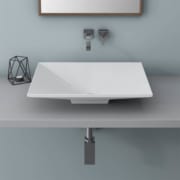A Short History of Sinks
Vessel sinks are everywhere these days and we thought we would shine some light on this bathroom feature’s history, beauty and practicality!
The popularity of vessel sinks appeals to the traditionalist as well as to the innovator. It reminds us of the old basins and pitchers and yet allows us to take advantage of modern materials and create elegant, inspirational and durable designs. Whimsical or practical, elegant or massive – the choice is yours. Rather than a boring sink that matches your toilet and tub, you can now make the sink the focal point of your personal creation. Vessel sinks are beautiful, practical and let you express your personal style!
The History of Vessels, Sinks, and Basins
Basins… have been around since the beginning of civilization – an indentation in rock served as a washbasin for our forefathers. Our English word basin comes from the old French word baçon, meaning shallow vessel or dish. Those basins were just basins and didn’t have a drain or plug or other conveniences. What we call sinks are in fact ‘basins’ from which the water ‘sinks’.
The term sink likely comes from the old English term ‘sincan’ – to become submerged, go under, or subside. Originally it referred to the place to where the contents of your basin would sink.
Which brings us to vessel. This term comes from the old Latin ‘vascellum’ meaning vase or urn or ship.
All in all, just as words adapt through time, so do style and design trends. Which is why classic, elegant, conversation-starting vessel sinks are today’s best choice.
Our Calma Collection
ICO carries a line of vessel sinks called Calma. The name Calma recognizes that, for most of us, our bathrooms should be a relaxing retreat from the daily hustle, a place of relaxation. A place of calm.




Etymology is so cool! I love learning about the origin of words.
And you’re right, the word “sink” has become more simple and elegant over time, so it’s only fitting that your products reflect that 🙂